
I just spent an incredible week in the city of Segou with
Groupe Bogolan Kasobane, the people responsible for bringing Bogolanfini into the fine art world. Although the original group consists of 6 artists, they also run a studio/gallery made up of over 15 artists.

It is in this beautiful and creative environment that I learned how to make my own pieces of art out of cotton, clay, and all natural dyes.
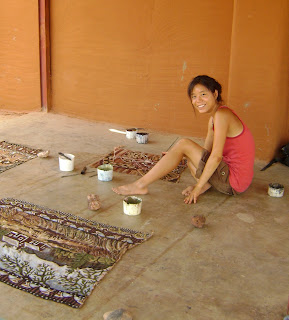
Boubacar Doumbia, the founder of the group; introduced me to the origins, process and many symbols of this medium.

It starts with Basilanfini, a fabric dyed from the leaves of the “ngalama” plant (yellow) and the bark of the “npeku” tree (red). Both contain a chemical called tannin which has been used as medicine and an antiseptic by the Bamara tribe of Mali for centuries. “Basilanfini” thus translates to “medicine cloth” and has been worn traditionally by Malians for protection and healing.

Legend has it that a hunter wearing basilanfini carried home an animal covered in clay which reacted with the tannin in the fabric to stain it a permenant black. That is how “Bogolanfini” or “clay cloth” was born.

The process is long and involves first dying the fabric multiple times to make basilanfini, then painting on the clay before applying multiple layers of a bleachlike substance and natural dyes to produce a finished work.

I can’t believe I managed to make 7 pieces of bogolanfini in 7 days! Here they are drying in the sun.

I seriously LOVE this technique which uses the colors and materials of the earth. Why has no one combined bogolan with batik? The dyes are used cold and would be the perfect solution to the problem of using natural dyes with wax!
 I just spent an incredible week in the city of Segou with Groupe Bogolan Kasobane, the people responsible for bringing Bogolanfini into the fine art world. Although the original group consists of 6 artists, they also run a studio/gallery made up of over 15 artists.
I just spent an incredible week in the city of Segou with Groupe Bogolan Kasobane, the people responsible for bringing Bogolanfini into the fine art world. Although the original group consists of 6 artists, they also run a studio/gallery made up of over 15 artists.  It is in this beautiful and creative environment that I learned how to make my own pieces of art out of cotton, clay, and all natural dyes.
It is in this beautiful and creative environment that I learned how to make my own pieces of art out of cotton, clay, and all natural dyes. Boubacar Doumbia, the founder of the group; introduced me to the origins, process and many symbols of this medium.
Boubacar Doumbia, the founder of the group; introduced me to the origins, process and many symbols of this medium.  It starts with Basilanfini, a fabric dyed from the leaves of the “ngalama” plant (yellow) and the bark of the “npeku” tree (red). Both contain a chemical called tannin which has been used as medicine and an antiseptic by the Bamara tribe of Mali for centuries. “Basilanfini” thus translates to “medicine cloth” and has been worn traditionally by Malians for protection and healing.
It starts with Basilanfini, a fabric dyed from the leaves of the “ngalama” plant (yellow) and the bark of the “npeku” tree (red). Both contain a chemical called tannin which has been used as medicine and an antiseptic by the Bamara tribe of Mali for centuries. “Basilanfini” thus translates to “medicine cloth” and has been worn traditionally by Malians for protection and healing.  Legend has it that a hunter wearing basilanfini carried home an animal covered in clay which reacted with the tannin in the fabric to stain it a permenant black. That is how “Bogolanfini” or “clay cloth” was born.
Legend has it that a hunter wearing basilanfini carried home an animal covered in clay which reacted with the tannin in the fabric to stain it a permenant black. That is how “Bogolanfini” or “clay cloth” was born.  The process is long and involves first dying the fabric multiple times to make basilanfini, then painting on the clay before applying multiple layers of a bleachlike substance and natural dyes to produce a finished work.
The process is long and involves first dying the fabric multiple times to make basilanfini, then painting on the clay before applying multiple layers of a bleachlike substance and natural dyes to produce a finished work. I can’t believe I managed to make 7 pieces of bogolanfini in 7 days! Here they are drying in the sun.
I can’t believe I managed to make 7 pieces of bogolanfini in 7 days! Here they are drying in the sun. I seriously LOVE this technique which uses the colors and materials of the earth. Why has no one combined bogolan with batik? The dyes are used cold and would be the perfect solution to the problem of using natural dyes with wax!
I seriously LOVE this technique which uses the colors and materials of the earth. Why has no one combined bogolan with batik? The dyes are used cold and would be the perfect solution to the problem of using natural dyes with wax!
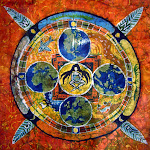


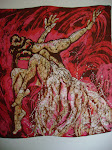

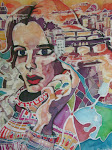
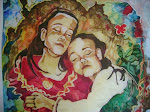

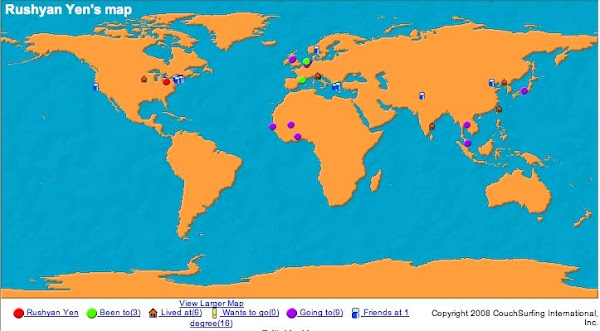
2 comments:
What a magical place it seems
Such an interesting piece about Groupe Bogolan, Rushyan. I haven't seen the process illustrated like this before although I knew (vaguely) how the technique works.I did use red and grey Devon clay in some work a year or so back, but as a pigment on a soy milk ground rather than as a dye. I don't think I showed this work to you when you stayed. But I never thought about using wax as well. We look forward to reading more.. Isabella
Post a Comment